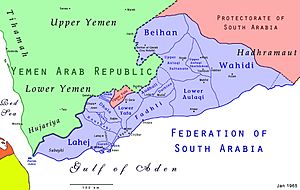Lower Aulaqi Sultanate facts for kids
Quick facts for kids Lower Aulaqi Sultanate
سلطنة العوالق السفلى
|
|||||||||
|---|---|---|---|---|---|---|---|---|---|
| State of the Federation of South Arabia | |||||||||
| 18th century–1967 | |||||||||
 Map of the Federation of South Arabia |
|||||||||
| Capital | Ahwar | ||||||||
| • Type | Sultanate | ||||||||
| Historical era | 20th century | ||||||||
|
• Established
|
18th century | ||||||||
|
• Disestablished
|
1967 | ||||||||
|
|||||||||
The Lower Aulaqi Sultanate was a small state that existed in a region now part of Yemen. It was known by its Arabic name, Salṭanat al-‘Awālaq al-Suflá. This sultanate was once part of larger groups of states, like the Aden Protectorate and later the Federation of South Arabia. Its main city, or capital, was Ahwar.
Contents
History of the Lower Aulaqi Sultanate
The Lower Aulaqi Sultanate was formed in the 18th century. Its leaders, called sultans, separated from the Upper Aulaqi Sultanate around that time. Another nearby state, the Upper Aulaqi Sheikhdom, also became separate around the same period.
Early Agreements with Britain
In 1855, the British government, through its representative in Aden, made an agreement with Sultan Munassar bin Bubakar bin Mehdi. This agreement stated that the sultan would stop the trade of enslaved people from Africa into his land. Sadly, Sultan Munassar and his son Abdulla were killed in 1863. His cousin, Bubakar bin Abdulla, became the new sultan.
Sultan Bubakar bin Abdulla did not have complete control over all the tribes in his area. This sometimes made it hard to prevent attacks on ships that crashed near his coast. However, in 1871, he signed another agreement. He promised to do his best to stop such attacks and to help any sailors who were shipwrecked, even taking them to Aden if needed.
Conflicts and Treaties
In 1883, there were disagreements between the Fadhli tribe and the Lower Aulaqi. This led to a fight where the Lower Aulaqi suffered a big loss.
The British signed a special agreement called a Protectorate Treaty with the Sultan in 1888. This treaty was officially approved in 1890. This meant that Britain would protect the sultanate, but it also gave Britain some influence over the area.
Changes in Leadership
In 1892, Sultan Bubakar stepped down from his role. His distant relative, Salih bin Ali bin Nasir, took over. The British government approved this change and continued to pay a regular amount of money to the new sultan.
Sultan Salih bin Ali bin Nasir also resigned in 1900. Sultan Ali bin Munassar then became the ruler. He died in 1902, and Sultan Nasir bin Bubakar took his place.
In 1904, a small conflict started again between the Fadhli and Lower Aulaqi tribes. Some Fadhli tribesmen fired at a Lower Aulaqi boat. This brought back old rivalries, but there wasn't much fighting, and a truce was declared by the end of the year.
Sultan Hasir bin Bubakar died in 1912, and Sultan Bubakar bin Nasir became the next ruler.
In 1924, Sultan Bubakar chose to give up his position. His cousin, Munassar bin Ali, became the new sultan. The British government recognized him as the leader and continued the annual payments.
In 1929, a Greek ship called the Hermes ran out of fuel and got stuck near Ahwar. The Lower Aulaqi Sultan successfully followed the terms of his agreement to help with the ship's rescue.
Sultan Munassar bin Ali died in April 1930. For a while, no new sultan was chosen because of disagreements within the ruling family.
Later Years and End of the Sultanate
In 1931, it was estimated that about 15,000 people lived in the Lower Aulaqi Sultanate. The total income of the sultanate was about 10,000 US dollars per year.
The sultanate joined the Federation of Arab Emirates of the South in February 1960. Later, in January 1963, it became part of the Federation of South Arabia. These were groups of states that worked together.
The Lower Aulaqi Sultanate came to an end in 1967. The last sultan, Nasir ibn Aidrus Al Awlaqi, and Prince Ali Abdullah, who was a governor, were imprisoned. This happened when the People's Republic of South Yemen was founded. Today, the area where the sultanate once stood is part of the Republic of Yemen.
Rulers of the Lower Aulaqi Sultanate
The leader of the Lower Aulaqi Sultanate was known by the title Sultan al-Saltana al-`Awlaqiyya al-Sufla. Here is a list of the sultans who ruled:
Sultans
- .... - .... `Ali ibn Munassar al-`Awlaqi
- .... - .... al-Mahdi ibn `Ali al-`Awlaqi
- .... - .... `Ali ibn al-Mahdi al-`Awlaqi
- .... - .... `Abd Allah ibn `Ali al-`Awlaqi
- .... - .... Nasir ibn Abi Bakr al-`Awlaqi
- 1855? - Jul 1863 Munassar ibn Abi Bakr al-`Awlaqi
- 1863 - 1892 Abu Bakr ibn `Abd Allah al-`Awlaqi
- 1892 - 1900 Salih ibn `Ali al-`Awlaqi
- 1900 - 5 Dec 1902 `Ali ibn Munassar al-`Awlaqi
- 6 Dec 1902 - 1912 Nasir ibn Abi Bakr al-`Awlaqi
- 1912 - 1924 Abu Bakr ibn Nasir al-`Awlaqi
- 1924 - Apr 1930 Munassar ibn `Ali al-`Awlaqi
- 1930 - 1947 `Aydarus ibn `Ali al-`Awlaqi
- 1947 - 29 Nov 1967 Nasir ibn `Aydarus al-`Awlaqi
See also

